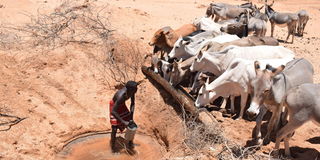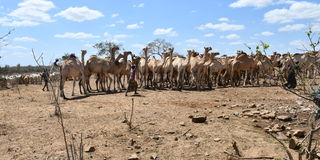Premium
Lives at stake as famine, hunger ravage villages

A man walks past a cow carcass in Mandera County. For three consecutive years, the county has not received any rainfall, leading to drought.
Ms Margaret Nkatha and her three children had not eaten for two days when she learnt that men were chopping up a dead camel and giving away the meat at Igembe Central in Meru. She rushed to the scene in Malaene village, Athiru Rujiine ward, and got about two kilos that she cooked and they ate.
That was the start of her tribulations. On Wednesday night, Nkatha and her three children were among the 112 people rushed to hospital, complaining of stomach pains and diarrhoea, while 44 others were taken on Thursday. Speaking from her hospital bed, the frail woman said they had no option. “I took the meat home, cooked and ate it with my husband and three children. The following day, we fell sick and were brought to hospital, but my husband refused to accompany us,” she said, adding she did not know his whereabouts.
She acknowledged that while they had been informed that the camel had died on Monday, but that did not deter them as they were hungry. “We had gone without food for two days; my children were pestering me on when they were going to eat. How could I have refused to give them meat that was readily available?”
A tour of the village yesterday painted a drought-stricken area, with residents saying it had not rained for six seasons. There is little vegetation and the scorching sun tells a different story from other parts of Meru County.
The residents said they feasted on the dead animal on Monday and Tuesday to suppress their hunger pangs resulting from the ravaging drought. After the meal, seven people were admitted to Maua Level Four Hospital, while 112 others were treated for food poisoning and discharged.
Mr Joel Njagi, who was treated and discharged on Friday, said the last time they harvested beans and maize, the main crops they grow in the area, was three years ago. “This is not the first time this has happened and even if it does again people will eat the meat. Maize flour is expensive and most of us cannot afford it. We are suffering due to the drought and we call upon well wishes to come to our aid.”
A nurse at the hospital said they had appealed to residents of the area who were still holding onto some pieces of the meat to surrender it for testing.

A Samburu herdsboy watering livestock at Kom area on September 19, 2022. About 4.43 million Kenyans are facing starvation due to prolonged drought and erratic rains.
Dr Githu Wachira, the hospital medical superintendent said the patients were out of danger and would be discharged by tomorrow. “Some of them were in serious condition, suffering from diarrhoea and headaches, but we were able to stabilise them, we did not lose any. We will give full reports about the chemical in the meat once it is established.”
Relief
Igembe Central is one of the areas in Meru that is hard hit by drought, even as the Kenya Red Cross Society indicates that at least 200,000 people are in need of food aid across the county.
Mr Denis Were, Red Cross county coordinator, said they had started distributing food to 504 households that were seriously affected, adding that a cash transfer programme where each household was getting Sh5,747 was in place. “We have disbursed Sh8.7 million from June to August and expect to release more money soon for the months of July and August. We are doing this in collaboration with CBM Global, FAO (Food and Agricultural Organisation) and other donors, including the county disaster management department.”
He listed the sub-counties that are hard hit by drought in Meru as Igembe Central, Igembe North and Tigania East.
According to Igembe Central Member of Parliament Dan Kiili, the situation is dire, with people going without food for several days. “I am meeting with officials of the national disaster management on Wednesday next week to deliberate on how to help our people because they are suffering,” Mr Kiili told Sunday Nation in a phone interview yesterday.
Among those who visited residents were area Member of County Assembly Julius Kabira and Assistant Chief Joel Mucheke, who appealed to residents to desist from eating uninspected meat.
Food scarcity is attributed to failure of crops planted in April and May due to drought.

Women carrying firewood walk past a carcass of a cow in Loiyangalani, which is the worst affected by the prolonged drought, in Marsabit, northern Kenya, on July 12, 2022. Several hard-hit counties in Northern Kenya are set to receive funds through the drought management agency.
A report released by the Ministry of Health, Kenya Food Security Steering Group and Early Warning Systems Network last month indicates that families in Samburu, Marsabit, Isiolo, Garrisa, Mandera and Wajir are in urgent need of humanitarian assistance due undernourishment.
About 4.43 million Kenyans are facing starvation due to prolonged drought and erratic rains.
Several hard-hit counties in Northern Kenya are set to receive funds through the drought management agency, to reduce the impact of malnutrition in families, especially children.
Worse still, majority of elderly residents whose lives entirely hinged on livestock are distraught after losing all their animals to drought that has claimed more than one million livestock in Marsabit alone.
Elle Borr village resident Guyo Ali told Sunday Nation that some depressed elderly persons in their area are currently entertaining suicidal thoughts.
John Kolkoboha from Kambinye area in Laisamis constituency said that he had completely lost hope and could no longer bear seeing his wife and two young children going hungry for up to two days. “I am so devastated because I don’t have any food to provide to my family. I am appealing for help because hope to cater for my family is diminishing. We seriously need help,” said Kolkoboha, shedding tears.
Dabel resident Boya Guyo also decried the unbearable living standards, worsened by the loss of livelihoods.
In Tharaka Nithi, more than 38,517 people are suffering from effects of drought. Data by NDMA shows that the semi-arid parts of Tharaka constituency are worst hit. The County NDMA coordinator Kiragu Kariuki said that approximately 7,704 households in the lower sides of Gatunga, Chiakariga, Mukothima, Marimanti and Nkondi wards are affected.
“We are in the stressed phase of the drought and approximately 38,317 people are in need of food support in Tharaka constituency,” said Mr Kariuki.
Most of the rivers that flow throughout the year have dried up, threatening lives of the people and livestock. Two weeks ago, some 150 vulnerable households received food donations from the Kenya Red Cross Society.
Kenya Red Cross Tharaka Nithi County coordinator Jerusha Nyaga said 523 hunger-hit households had also been enrolled in a cash transfer Emergency Drought Response Programme.
Crop failure
In Embu thousands of Mbeere residents are starving due to the biting drought that has hit the area. All the crops, which include maize, dried up before they matured following a prolonged dry spell, leaving residents without anything to eat.
Most affected areas are Kiambeere, Makima, Mwea and Mavuria villages where residents are struggling to survive. Former Member of Parliament Geoffrey King’ang’i said the situation was serious as residents did not harvest anything in two seasons.
“Last season, we did not witness rainfall and all the crops were wiped out by the scorching sun. This season, the situation is the same and something urgent should be done to save the lives of my people,” said Mr King’ang’i.
In Murang’a, at least 250,000 of the total 1.02 million populations are listed as threatened by hunger owing to ravaging dry spell. They are in the lowlands of the county especially in Ithanga/Kakuzi, Kiharu and Kigumo Sub-Counties, reprieve being expected in November when October rainy season will replenish fodder and food.
County Commissioner Karuku Ngumo said the emergency mitigation teams are cooperating with both the central and county governments to offer relief food.
Mr Ngumo said rain fed agriculture in the county is a big fallacy and suggested that all efforts towards actualising irrigation agriculture be pursued.

Pastoralists with their herd of camels at the Dingiria water pan in Sokoke ward in Ganze, Kilifi County. A report by the National Drought Management Authority (NDMA) indicates that families in 23 arid and semi-arid counties are faced with food shortages and inadequate pasture and water
“We are also rallying those blessed with material wealth to exercise good and compassionate neighbourhoods to donate food to starving neighbours,” he said.
In Laikipia, a total of 183,000 people are affected by drought, according to figures released by the NDMA. County NDMA coordinator Golicha Guyo told the Nation that though some rainfall had been experienced in parts of the region, many households were affected by hunger especially in Laikipia North Sub-County. “We have received some rain in parts of Laikipia East and Central but the situation hasn't changed much. Looking North occupied mainly by pastoralists is in need of food aid,” said Mr Guyo on the phone.
He added that between 5,000 and 7,000 head of cattle were still in Mt Kenya and Aberdare forests where they were driven early this year in search of pasture. Some are from neighbouring counties of Isiolo, Samburu and Meru.
Data from the local office of the Kenya Red Cross indicates that some 2,313 cows, sheep and goats have been slaughtered in the livestock off-take programme, which is a joint coordination between Kenya Meat Commission, Ministry of Interior, Kenya Red Cross and NDMA involves slaughtering livestock affected by hunger and distributing the meat to locals as relief food. Red Cross yesterday said most households in some counties in the Rift Valley were experiencing food deficit that was likely to worsen because of crop failure due to prolonged dry spell.
Hard-hit counties include Turkana, West Pokot and parts of Baringo and Elgeyo Marakwet where several families have exhaust their food stocks.
In Turkana, more than 30,000 residents have crossed to Katido and Kaboong districts in Uganda in search for food, pasture and water. Some 8,000 children and 5,365 mothers are faced with severe malnutrition.
According to Red Cross North Rift manager Esther Chege thousands of families in drought-hit counties depend on relief supplies which have seen response agencies intensify efforts to cushion famine-stricken families against starvation. She disclosed that the KRCS, county governments and National Disaster Management Authority was coordinating distribution of relief supplies to the families.
“Acute shortage of maize has emerged as the main challenge as the cost of essential commodities skyrockets making it difficult for most families to have a meal,” added Ms Chege.
Some families in Turkana, West Pokot and Baringo have turned to charcoal burning to get some money to buy food. “The food crisis as a result of the unrelenting drought is contributing to environmental destruction due to wanton harvesting of trees for charcoal burning to get money and buy food,” said Ms Chege.
Over 30,000 livestock have died, hence de-stocking is necessary.
By Gitonga Marete, Barnabas Bii, Jacob Walter, Alex Njeru, Mwangi Ndirangu, Mwangi Muiruri and Martin Mwaura





